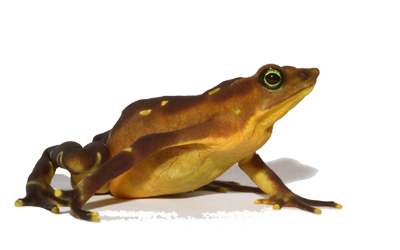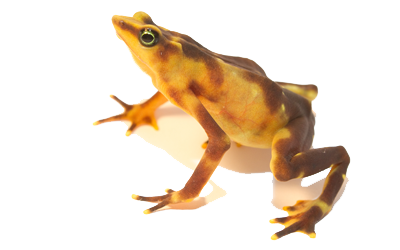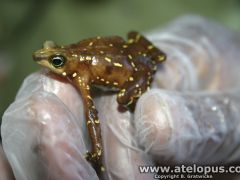Atelopus glyphus
Class Amphibia - Amphibians » order Anura » family Bufonidae - Toads
Atelopus glyphus - Dunn, 1932
Size male: 36 mm.
Size female: 48 mm.


Atelopus glyphus - photos (C) B. Gratwicke
Geographic Range
Native to Darien (Panamá and Colombia). Serranía de Pirre, above Cana.
This species is endemic to the eastern part of Panamá and probably also lives at the Colombian side of the border, but it has to be confirmed. Occurs in the upper parts of Río Limón at altitudes between 1200 and 1445 meter above seas lever (asl).
Population
Apparently this species where stil common in the slopes on the edge to Pierre Colombia in September 2002 but this has to be confirmed.
No material from the Colombian side are confirming their presence by scientific or in inventories lists of species made in Parque Nacional Natural Los Katios (National Natural Park in Darien Katios).
The species has been recorded from two protected areas: Parque Nacional Darién (a World Heritage Site) in Panama and Parque Nacional Natural los Katíos in Colombia. In view of the severe risk of chytridiomycosis, the status of this species should be closely monitored, and ex-situ populations should be established.
Atelopus glyphus is considered to be generally common within its known range. Last seen 2002 (R. Ibáñes). If you have observed this species later, please contact us.
Habitat
This is a terrestrial species inhabiting tropical montane and submontane forest. Breeding and larval development takes place in forest streams.
Coloration
Atelopus glyphus dorsal are normally uniform brown or more sepia colored. There are sometimes yellowish-white spots and sometimes a small coffee colored dot or central line. The ventral side is immaculate yellow. The skin is nearly smooth. The iris of the eye is green.
Conservation
Amphibian Ark has chosen Atelopus glyphus for the first ever Facebook fundraiser to save an endangered species.
The goal is to raise $53,000 by June 2, 2009, for a species-specific rescue facility and costs associated with the first year of operation. The "amphibian pod" rescue facility will be based at the Summit Zoo in Panama City, Panama. It will begin with about 20 wild-caught breeding pairs, eventually reaching up to 500 frogs including captive-bred offspring. Initial breeding efforts at the El Valle del Anton Amphibian Conservation Center in Panama were successful, indicating this species is a good candidate for captive management until wild populations can be re-established.
The rescue facility itself consists of a 40' shipping container, modified to include shelves, tanks, plumbing, an electrical system, HVAC (heating, ventilation and air conditioning), a water heater, and a repressurization pump and water storage container, as well as a large window for public viewing. The container itself, plus modification, plus shipping to Panama and hooking up to utility lines, costs a total of approximately $41,000. The first year of operating costs will be $12,000.
The concept of using a modified shipping container as an "amphibian pod" rescue facility was pioneered in Australia. The Summit Zoo hopes eventually to use a number of these "amphibian pods" to house more colonies of endangered amphibians from the central region of Panama, where chytrid has had a severe impact.
Sources, References, more information & links
Roberto Ibanez, Cesar A. Jaramillo & Frank A Solis (1995) - A new species of Atelopus from Panama. PDF acessible.
Roy W. McDiarmid (1971) - Comparative Morpholgy and Evolution of Frogs of the Neotropical Genera Atelopus, Dendrophryniscus, Melanophryniscus and Oreeophrynella. PDF accessible.
Roberto Ibáñez, Frank Solís, César Jaramillo, Querube Fuenmayor, Stefan Lötters, Jose Vicente Rueda, Andrés Acosta-Galvis 2004. Atelopus glyphus. The IUCN Red List of Threatened Species. Version 2015.2. <www.iucnredlist.org>



